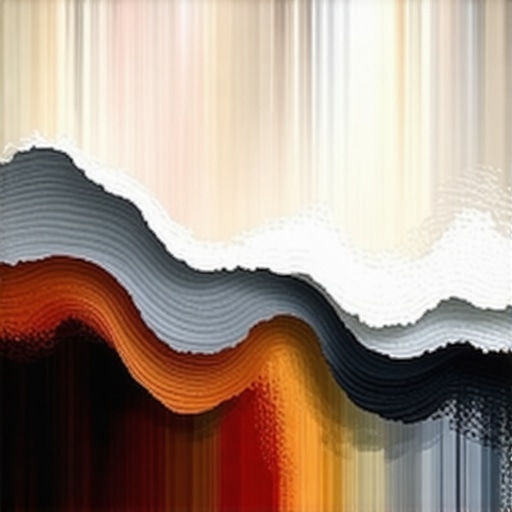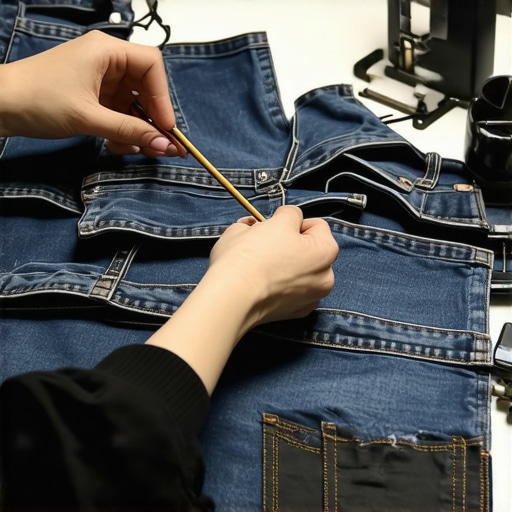My Journey into Denim Upcycling: Turning Old Jeans into Fashion Statements
It all started when I was cleaning out my closet and stumbled upon a pile of worn-out denim jeans. Instead of tossing them away, I realized they could be transformed into something stylish and eco-friendly. This personal project not only gave my old jeans a new life but also sparked my passion for sustainable fashion.
Discovering the Art of Upcycling Denim: More Than Just Recycling
Upcycling denim is an exciting way to create unique jackets and bags that reflect your personal style. I learned that by combining basic sewing skills with some creativity, I could craft items that are both fashionable and environmentally conscious. For example, I made a chic denim jacket by patching different pieces together, giving it a vintage-inspired look that became my go-to outfit for casual outings.
Practical Tips for Upcycling Discarded Denim into Wearable Art
One of the key insights I gained is the importance of selecting sturdy denim pieces. Thinner fabrics tend to wear out quickly, so I prefer using thicker, high-quality jeans. I also recommend adding embellishments like embroidery or fabric paint to personalize your creations. For those interested in beginner-friendly projects, there are countless tutorials on sites like DIY projects for beginners.
How Can You Turn Old Denim into Something Truly Unique?
What creative techniques can elevate simple upcycled denim into standout fashion pieces?
Experimenting with distressing, bleaching, or adding patches can dramatically change the look of your denim projects. I once used bleach to create a tie-dye effect on a pair of jeans, resulting in a one-of-a-kind piece. Also, incorporating other upcycled materials like leather or canvas can add texture and durability. For inspiration, check out creative DIY crafts.
If you’re curious about the environmental impact of upcycling and want to learn more about sustainable practices, I suggest reading this comprehensive guide by experts in eco-friendly DIY.
I’d love to hear your thoughts or personal experiences with denim upcycling. Feel free to share your stories in the comments or explore more creative ideas with me!
Unlocking the Secrets of Sophisticated DIY Home Renovation
Embarking on advanced DIY projects elevates your home improvement game from basic repairs to professional-level craftsmanship. Whether you’re installing intricate tile patterns or restoring vintage furniture, understanding the nuances of these techniques can make a significant difference. For example, mastering restoration techniques for antique furniture allows you to preserve history while enhancing durability and aesthetics.
Developing a Nuanced Approach to DIY Wall Treatments
Wall treatments such as textured finishes or custom murals require a blend of artistic vision and technical skill. Advanced methods like pattern matching and seamless wallpaper installation are essential for achieving a flawless look. Incorporating techniques like Venetian plaster or faux finishes can add depth and sophistication to your interiors, making your home stand out with personalized elegance.
How Can Professionals Push the Boundaries of DIY Decor?
What innovative materials or tools can transform traditional DIY into high-end design?
Utilizing cutting-edge materials such as epoxy resin for creating custom countertops or decorative art pieces can dramatically elevate your projects. Similarly, tools like digital laser measuring devices or 3D modeling software enable precise planning and execution, reducing errors and enhancing the final outcome. For inspiration, explore creative DIY decor ideas that blend technology with craftsmanship.
Implementing eco-friendly practices, such as using natural, sustainable pigments for staining or eco-conscious sealants, aligns your projects with modern sustainability standards. Additionally, understanding the principles of ergonomic design in DIY workspace setups ensures your environment is both productive and comfortable, a crucial aspect for long-term projects.
For those eager to refine their skills further, engaging with advanced staining and sealing methods can enhance the longevity and beauty of outdoor wooden features, turning a simple deck into a stunning focal point.
What Are the Practical Challenges and How Can They Be Overcome?
Dealing with uneven surfaces, moisture issues, or imperfect materials requires patience and expert techniques. Learning how to properly prepare surfaces, choose suitable adhesives, and apply finishes with precision ensures a professional result. Online resources and expert tutorials provide valuable guidance, but hands-on practice remains irreplaceable for mastering these skills.
If you’re interested in expanding your DIY repertoire, consider exploring beginner-friendly projects to build foundational skills before tackling more complex endeavors. Sharing your experiences and challenges in the comments can also foster a community of passionate DIY enthusiasts eager to exchange tips and inspiration.
Refining My Skills: Embracing the Nuances of Advanced DIY Home Decor
Over the years, I’ve discovered that true mastery in DIY home decor involves a deep understanding of materials, techniques, and the subtle art of finishing. For example, when working with textured finishes like Venetian plaster, I learned that patience and precise application are essential to achieve a seamless, sophisticated look. This process taught me that every brushstroke or trowel swipe impacts the final aesthetic, making it feel more like a crafted masterpiece than a simple renovation.
How Do You Achieve Flawless Pattern Matching in Complex Wall Treatments?
Pattern matching in wallpaper or murals can be surprisingly challenging, especially when working with intricate designs. I remember spending hours measuring and aligning patterns, adjusting my approach as I learned the importance of pre-planning and practicing with scrap materials. Advanced techniques involve using pattern guides or projectors to ensure seamless continuity, which elevates the overall look and provides a professional finish. For those interested, exploring pattern matching tutorials can be incredibly helpful.
What Creative Materials Are Transforming the Future of DIY Home Decor?
Innovative materials are opening new horizons for DIY enthusiasts. For instance, epoxy resins now allow for stunning, durable finishes on countertops and decorative art pieces. I’ve experimented with epoxy to embed objects or create translucent effects that add depth and texture. Additionally, natural pigments derived from earth or plants, as discussed in eco-friendly pigments, enable sustainable yet vibrant color options that harmonize with the environment. These materials push the boundaries of what’s possible in DIY projects, making each piece a unique statement of craftsmanship and sustainability.
By continuously exploring and experimenting with such advanced techniques and materials, I’ve found that the process becomes as rewarding as the finished project. Sharing these experiences and insights can inspire others to push their creative limits and develop their own signature style—so I encourage you to comment below with your experiences or questions. Together, we can elevate the art of DIY home decor to new heights.
Harnessing the Power of Layered Textures for Sophisticated Wall Art
One of the most rewarding pursuits in advanced DIY home decor is mastering layered textures, such as Venetian plaster and faux finishes. These techniques demand patience and a keen eye for detail, transforming ordinary walls into captivating focal points. I found that employing multiple thin coats and blending different shades creates a sense of depth that elevates the entire room’s aesthetic. For those eager to push their skills further, exploring encaustic painting methods can introduce new layers of complexity and vibrancy to your decor projects.
Integrating Innovative Materials for Unique Home Accents
Advanced DIY projects are increasingly characterized by unconventional materials that challenge traditional design boundaries. Epoxy resin, for example, allows for creating stunning, durable surfaces embedded with objects or translucent color effects, turning functional pieces into art. I experimented with embedding natural elements like leaves or stones within epoxy to craft one-of-a-kind tabletops and decorative panels. Additionally, natural earth pigments, as discussed in eco-friendly pigments, enable sustainable color solutions that harmonize with eco-conscious interiors. Pioneering the use of such advanced materials has profoundly expanded my creative possibilities, transforming simple DIY into high-end design.

Unlocking the Secrets of Precision Pattern Matching in Complex Wall Coverings
Pattern matching in wallpaper installation or murals can be one of the most intricate aspects of advanced home decor. I’ve learned that meticulous pre-measurement, combined with the use of pattern guides or projectors, ensures seamless continuity. Achieving a flawless match requires not only technical skill but also an artistic sensibility, especially when working with intricate designs. Practice with scrap materials and patience are essential, and the reward is a professional-looking finish that elevates the entire space. For in-depth techniques, I recommend exploring pattern matching tutorials, which have significantly refined my approach.
Embracing Sustainability Through Advanced Upcycling Strategies
Sustainability remains at the core of my DIY journey, particularly through innovative upcycling strategies that involve repurposing reclaimed materials into luxurious accents. For instance, I transformed scrap metal into sculptural art pieces that serve as statement decor items, blending craftsmanship with eco-consciousness. Similarly, using natural pigments derived from earth not only reduces chemical usage but also results in beautiful, authentic finishes. These advanced techniques require careful planning and skill, but the payoff is a personalized, environmentally friendly aesthetic that tells a compelling story. I invite you to share your experiences or ask questions about pushing the boundaries of sustainable home decor, as collective knowledge elevates our craft.
Things I Wish I Knew Earlier (or You Might Find Surprising)
Patience Is a Virtue in DIY
Looking back, I underestimated how much patience and persistence are essential in mastering complex DIY techniques. Early on, I often felt frustrated when things didn’t turn out perfect the first time. Over time, I learned that embracing mistakes as part of the learning process made the journey more enjoyable and rewarding.
Every Project Tells a Story
Each DIY project I undertake becomes a personal story—often reflecting my mood, creativity, and even my challenges. For instance, the upcycled denim jacket I crafted not only saved old jeans but also became a symbol of my commitment to sustainability and self-expression.
Quality Over Quantity Matters
I used to think that completing a lot of projects quickly was the goal, but I’ve discovered that focusing on quality and attention to detail leads to more satisfying results. Investing time in learning techniques, like pattern matching or surface finishing, truly elevates my work.
Resources Are Your Best Friends
Having access to reliable tutorials, online communities, and expert advice is invaluable. I often revisit trusted sources like DIY guides or join forums to troubleshoot and get inspired. They keep me motivated and learning.
The Joy of Sharing and Teaching
Sharing my DIY experiences with friends or online communities not only reinforces my skills but also fuels my passion. Teaching others what I’ve learned creates a sense of accomplishment and keeps the creative energy flowing.
Resources I’ve Come to Trust Over Time
- DIY Kutak Blog: This resource has been my go-to for comprehensive tutorials and innovative ideas, especially in advanced techniques for home decor and upcycling. Its detailed guides helped me push my boundaries.
- Instructables: A vibrant community platform where real people share their projects, troubleshooting tips, and creative solutions. It’s like having a global DIY club at your fingertips.
- YouTube Channels like Home Repair Tutor and DIY Crafts: Visual learning makes complex techniques more understandable. Watching step-by-step videos has improved my craftsmanship significantly.
- Book: “The Complete Book of DIY and Home Repair”: A timeless resource that covers fundamental skills and safety tips, providing a solid foundation for any DIYer.
Parting Thoughts from My Perspective
Reflecting on my DIY journey, I realize that the most valuable lesson is embracing the learning process itself. Whether I’m upcycling old materials, tackling advanced wall treatments, or experimenting with innovative tools and materials, each project enriches my skills and personal growth. I encourage anyone interested in DIY to start small, stay curious, and never hesitate to explore new techniques or resources like home decor ideas. The process is as rewarding as the finished piece, and every mistake is a stepping stone toward mastery. If this resonated with you, I’d love to hear your thoughts or see your own DIY adventures—feel free to share in the comments or reach out through my contact page.”}

